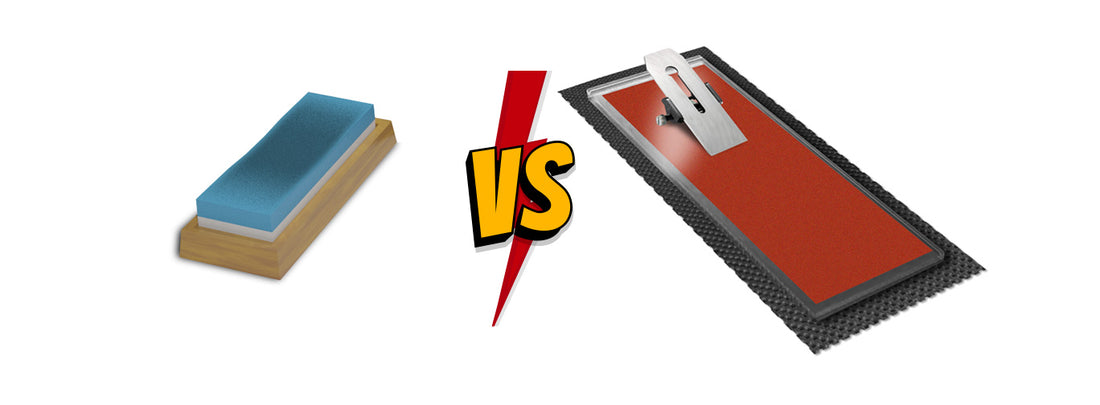
Scary Sharp Kit vs Sharpening Stones
Share
Comparing Two Sharpening Methods
Compared to stone sharpening and grinding, the scary sharp sharpening method is fairly new in the world of blade, tool and knife sharpening.
The general idea of the scary sharp method involves mounting the sandpaper or sharpening film on a hard, smooth surface and moving the blade back and forth across the abrasive, as one would with a sharpening stone.
The blade gets sharper and more refined as it is taken through a series of increasingly finer grades (or grit) of sandpaper or film. This system has caught on in popularity and is often used by professional chefs and craftsman, as it is an easy and efficient way to get a very sharp edge on a blade. But this method isn’t only for professionals, because of its simplicity, anyone can take advantage of this sharpening method. It’s easy, inexpensive, and setup takes no time at all. Best of all it is effective. This method leaves blades with a scary sharp edge (hence the name) in a short amount of time.
What Makes it Different from Other Sharpening Systems?
This depends on which system you compare it to. For example, whetstones or sharpening stones are similar by way in which the blade moves over the abrasive surface. The difference is with a stone, there will be a deviation, or a worn area typically in the middle as the stone is used. This will result in an uneven sharpening surface. To fix this, the stone will need to be flattened as it is necessary to have a flat surface to sharpen on.
With the scary sharp method, the sandpaper or sharpening film is disposable. When the abrasive is worn, you simply replace it with another sandpaper or sharpening film. The sharpening surface (typically glass or granite or some other hard smooth material) is not affected.
Stepping Through Grit Sizes
This is another similarity with both whetstones and scary sharp. The sharpening process begins with the more aggressive grits and you “step” your way down through a range of grit sizes until you have a polished edge. Whetstones don’t typically offer as many grit sizes as sharpening film or sandpaper. This means with a typical 2-grit stone you may have to jump from a 1000 to a 6,000 grit surface. This will require more work to get the blade sharp. On the other hand, you could purchase a complete set of sharpening films (ranging from 300 to 60,000 grit) for lesser cost than a stone. This would allow you to gradually step through the grit sizes and bring you to a sharper, mirror edge at a faster speed with less effort.
The Diamond Factor
Using diamonds to sharpen is a huge performance advantage. Diamond particles are the hardest known material, so they're perfect for cutting and sharpening metal. They're also incredibly durable. The downside to diamonds? Price. A stone diamond sharpening set can set you back a good amount of cash. Fortunately, diamond sharpening film is available for less than the cost of stones or diamond plates.
Aluminum Oxide
This is one of the most common choices when it comes to man-made sharpening materials and a very effective abrasive for sharpening. Aluminum oxide is used in sharpening stones, and sharpening film such as lapping and microfinishing film.
Which is Better? Scary sharp or Whetstones?
It mostly depends on your budget and use or maybe even personal preference. Both can produce a very sharp edge but which is right for you? Here is a comparison table that may help with your choice…
| Sharpening Stones | Scary Sharp | |
| Cost | Less expensive. | |
| Durability | Stone last longer but need to be flattened as the wear. | Films eventually need replaced with a fresh film or paper after multiple uses. Plate glass will never dish or wear. |
| Grit Options | Typically available in more grit sizes. | |
| Set Up | Stone may need to be soaked and flattened before using. | |
| Speed | If using fewer grit sizes, it may take more work to achieve a sharp edge. | Stepping through more grit sizes allows you to spend less time with each grit. |
